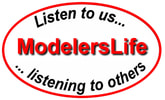 |
| NJ TRANSIT Somerville Station, Parking Lot at Rush Hour on a Tuesday. Where there's normally no available spaces, there are plenty today: Quarantine 2020 |
And, while this chaos was going on at work, most everyone stayed at home, there were mass layoffs, lots of fear and lots of uncertainty.
Still - where there is a will, there is a way. Rich W. is a big reason for the operational success of the Onondaga Cutoff, and he too was recently interviewed over on Lionel Strang's A ModelersLife podcast. You can listen here: Rich Wisneski on A ModelersLife
Lionel jokingly paraphrases Rich in the title. I disagree - Rich had a novel idea: recording some videos, perhaps via Facebook Live, on the Onondaga Cutoff to share the operation and railroad with viewers stuck at home during the quarantine. What a great idea! So, we went about doing just that. All are available at the official Onondaga Cutoff Facebook Page:
The first one was watched by up to 145 viewers at times - I was amazed. We had hundreds of comments, fun banter and a great time, albeit a bit too long. It got 2000 views in just one week. Many offered support and suggestions, which we took into consideration for a second video. That one got 2000 views - in 24 hours! We did a third, this time we have 4000 views after 48 hours and today, we eclipsed 5000 views on the most recent video. This is a bewildering number, and I am so grateful for the support and the enthusiasm people are showing.
As if that weren't enough, the most recent video was our first with operators socially distanced outside the walls - Rich and his son Andrew ran trains from the backyard, using FRS radios, WiThrottles on my WiFi network, and watching the dispatcher screen on the computer so as to monitor their progress across the railroad. Jack dispatched from Morristown. This allowed for more fluid operations and a more busy railroad, far more interesting to viewers.
Lionel Strang reached out again for an interview, which happened after the second video and premiered before the third video. That interview is available here: Dave Abeles and the Onondaga Cutoff - Goin' Live
THEN, and there is more - Alex Lang reached out with his computer networking experience, and offered to help set up a channel for WiThrottle to be truly remote - as in, sitting at home, and logging into the Onondaga Cutoff WiThrottle server to run trains on the layout. Remarkable! This was just last night and we have plenty to learn, but between our robust capability for remote dispatching, and this new possibility for remote operations - well, it's bewildering.
And so, reflecting back on this month is something else. Family is healthy and I hope the same for you. I'm thankful for the gift of health and reliable work, for community and this amazing hobby. There is a lot of tragedy out there today, and each of these deaths is a tragedy for families worldwide. In working to provide some positive distraction from that dark news, we've started something that seems to have a lot of traction in the model railroad community and indeed in the greater community as well.
My grateful thanks to you all - stay safe, and optimistic, in these trying times!
~RGDave

















